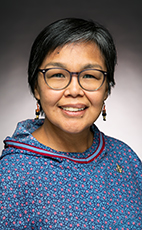44th Parl. 1st Sess.
December 2, 2022 10:00AM
Madam Speaker, I would like to note that the member's wife and I worked together for many years in Parks Canada, and we share a passion for the work the organization does.
Historic places have a huge opportunity to play a significant role in reconciliation. We have many designations, such as fur trade forts and military forts that, in many cases, do not recognize the indigenous relationships that existed over time. The changes I mentioned, such as bringing in indigenous representatives, first nations, Inuit and Métis, to the Historic Sites and Monuments Board of Canada, would help reflect on the commemorations and how they can help further advance reconciliation. Also, having those voices represented would help in new designations. This is a very exciting piece of legislation that would go much further in reconciliation than we have seen in the past from this program.
147 words
All Topics
- Hear!
- Rabble!
- add
- star_border
- share
Mr. Speaker, the Bloc Québécois will support this bill, which is clearly an opportunity for the government to kick-start its intentions of reconciliation with first nations and to implement some of the specific recommendations made by the Truth and Reconciliation Commission of Canada.
Bill C-23 creates three new positions on the Historic Sites and Monuments Board of Canada for first nations, Métis and Inuit representatives, thus improving the integration of indigenous history, heritage values and memory practices into Canada's history and national heritage.
Bill C‑23 is also in keeping with Canada's desire to honour its international commitments under the United Nations Declaration on the Rights of Indigenous Peoples. Article 15.1 of that declaration guarantees indigenous peoples “the right to the dignity and diversity of their cultures, traditions, histories and aspirations which shall be appropriately reflected in education and public information”. It also honours article 15.2.
The Bloc Québécois has been an early supporter of this UN declaration in terms of providing information and education on first nations traditions and cultures. As a strong advocate of a nation-to-nation relationship between Quebec, Ottawa and the indigenous nations, we are also working with them to strengthen and guarantee their inherent rights. We will continue our work to ensure that the federal government fully implements the UN Declaration on the Rights of Indigenous Peoples in areas of federal responsibility. Giving indigenous peoples an additional voice in the reconciliation process is fully consistent with our party's position.
Three main values guided the framework of Bill C‑23: inclusivity, sustainability and transparency. The board will now have one representative from each of the following: first nations, Inuit and Métis. Indigenous knowledge will now be a source of information to guide the board in its recommendations, along with community, scientific and academic knowledge. The inclusiveness of this proposal can only be commended.
The principle of sustainability comes across in the protection and conservation of historic places, including the “mandatory heritage evaluation of buildings that are 50 years of age and administered by federal authorities” and “improved access to information about historic places through a public register that supports decision-making and public interest”. That is set out in the bill.
There are deemed persons of historic significance and deemed historic events, as well as deemed historic places and classified buildings. Bill C‑23 would amend a number of acts, including the Parks Canada Agency Act as follows:
Paragraphs (l) and (m) of the fourth paragraph of the preamble...are replaced by the following:
(l) to maintain ecological integrity as a prerequisite to the use of national parks,
Obviously that is very important to us.
(l.1) to maintain commemorative integrity and heritage value as a prerequisite to the use of historic places...
I will give a very concrete example of the use of an historic place: the Ottawa Hospital's future Civic Campus, which is very near here. There was no shortage of contradictions, when it comes to talking about protecting historic heritage sites with great historic and ecological value that are unquestionably very important to thousands of Ottawans and certainly to indigenous groups in the region.
Let me ask a question: Is there a real protection mechanism for places and sites designated as “heritage” or any other combination of related words, such as “deemed”, “historic” or “of historic significance”?
Ottawa needs a hospital. There are criteria for choosing an optimal site that respects multiple factors, and the National Capital Commission is seized with proposing federal sites from the catalogue of sites under its management—
632 words
- Hear!
- Rabble!
- add
- star_border
- share
Uqaqtittiji, I realize that the member did not speak much to indigenous issues, but I will ask this question quickly.
Can the member speak to his party's experience with first nations, Inuit and Métis communities and the ongoing efforts or struggles they have with preserving and protecting indigenous heritage?
52 words
- Hear!
- Rabble!
- add
- star_border
- share
Uqaqtittiji, I rise today with fond memories, having attended Ataguttaaluk High School in Igloolik in my riding. I send out a special thanks to the Igloolik District Education Authority, Igloolik elders, Nunavut Research Institute, the late Graham Rowley, Susan Rowley, Carolyn MacDonald and John MacDonald. These amazing groups and individuals delivered an archaeology credit course that contributed to my high school diploma. I share my speech today, realizing how investments for youth can have lasting impacts. Qujalivakka. I am so grateful to them.
Bill C-23, an act respecting places, persons and events of national historic significance or national interest, archaeological resources and cultural and natural heritage is of particular importance to indigenous peoples in Canada.
I am glad to see, in Bill C-23, that roles are provided for indigenous peoples in determining historic places. It is great to see that the bill responds to the Truth and Reconciliation Commission's call to action 79. Specifically, the bill would add three members to the Historic Sites and Monuments Board, from first nations, Métis and Inuit groups. In addition, it would compel Parks Canada to incorporate indigenous knowledge into the designation and commemoration of historic sites.
Unfortunately, what the bill would do is not enough. The Truth and Reconciliation Commission's calls to action set a framework, and this framework should have been used in ensuring a better legislation.
The TRC call to action 79 specifically reads:
We call upon the federal government, in collaboration with Survivors, Aboriginal organizations, and the arts community, to develop a reconciliation framework for Canadian heritage and commemoration. This would include, but not be limited to:
i. Amending the Historic Sites and Monuments Act to include First Nations, Inuit, and Métis representation on the Historic Sites and Monuments Board of Canada and its Secretariat.
ii. Revising the policies, criteria, and practices of the National Program of Historical Commemoration to integrate Indigenous history, heritage values, and memory practices into Canada’s national heritage and history.
iii. Developing and implementing a national heritage plan and strategy for commemorating residential school sites, the history and legacy of residential schools, and the contributions of Aboriginal peoples to Canada’s history.
In 2017, the National Centre for Truth and Reconciliation raised concerns about the state of conservation of the 17 remaining residential schools and said it was urgent for the government to respond to call to action 79. It is unclear to me what has happened since 2017, and whether this bill addresses those concerns.
The Standing Committee on Environment and Sustainable Development's 2017 report entitled “Preserving Canada’s Heritage: The Foundation For Tomorrow” provided clear recommendations, which I will speak to in more detail later.
During its study, the Standing Committee on Environment and Sustainable Development learned that Canada is the only G7 country that has not passed legislation to protect historic places and archaeological resources under its jurisdiction. Unfortunately, alongside many other recommendations not implemented by this government and previous governments, this is not a new recommendation. In 2003, the Office of the Auditor General of Canada also recommended that the federal government strengthen the legal framework built for heritage in Canada.
The committee I mentioned earlier examined the issue of preserving indigenous heritage places. Unsurprisingly, the committee found that indigenous peoples define their heritage in a more holistic manner than the western model. As a result, solutions currently used to protect heritage places must be adapted in order to preserve indigenous heritage places.
The committee amplified the need to implement TRC calls to action 72 to 75, which create the process to commemorate the indigenous children who never returned to their families. Canada’s heritage includes genocide of indigenous peoples. As such, incorporating these calls to action is just as important as implementing call to action number 79. Indigenous peoples should be able to protect their own heritage. Indigenous-led heritage would involve coordination among communities, elders and knowledge keepers.
I will conclude by entering into the record recommendation 17 from the committee's report.
Recommendation 17 of the report also recommended that:
The Historic Sites and Monuments Board of Canada revise the policies, criteria, and practices of the National Program of Historical Commemoration to integrate Indigenous history, heritage values, and memory practices into Canada’s national heritage and history.
Parks Canada develop and implement a national heritage plan and strategy for commemorating and, where appropriate, conserving residential school sites, the history and legacy of residential schools, and the contributions of Indigenous peoples to Canada’s history.
The federal government, in collaboration with Residential School Survivors, commission and install a publicly accessible, highly visible, Residential Schools National Monument in the city of Ottawa to honour Survivors and all the children who were lost to their families and communities.
804 words
All Topics
- Hear!
- Rabble!
- add
- star_border
- share
- menumenu
- notificationsnotifications
- home
- mailmail
- searchsearch





